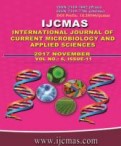


 National Academy of Agricultural Sciences (NAAS)
National Academy of Agricultural Sciences (NAAS)

|
PRINT ISSN : 2319-7692
Online ISSN : 2319-7706 Issues : 12 per year Publisher : Excellent Publishers Email : editorijcmas@gmail.com / submit@ijcmas.com Editor-in-chief: Dr.M.Prakash Index Copernicus ICV 2018: 95.39 NAAS RATING 2020: 5.38 |
Five non-fungicides viz., captan 50 WP, copper oxychloride 50 WP, dodine 65 WP, mancozeb75 WP, antracol 70 WP and five systemic fungicides viz., bitertanol 25 WP, carbendazim 50 WP, Difenconozole 25 EC, hexaconozole 5EC, and myclobutanil 10 WP were evaluated against chickpea wilt caused by Fusarium oxysporum f. sp. ciceris. The in-vitro evaluation of non -systemic fungicides through poisoned food technique at five different concentrations viz., 50, 100, 250, 500 and 1000 µg ml-1 indicated that two fungicides viz., dodine and captan proved the most effective exhibiting mean mycelial growth inhibition of 66.13 per cent followed by mancozeb with 51.42 per cent, respectively. Copper oxychloride proved least effective and resulted in only 23.79 per cent mean inhibition of mycelial growth. Systemic fungicides were also evaluated at different concentrations viz., 50, 100, 200, 400 and 500 µg ml-1 showed that carbendazim proved the most effective exhibiting mean mycelial growth inhibition of 92.17 per cent followed by difenconozole and hexaconozole with 76.52 and 71.18 per cent, respectively. Myclobutanil 10 WP proved to be the least effective and resulted in only 64.38 per cent mean inhibition of mycelial growth. Three strains of Trichoderma viride designated as Tv1, Tv2 Tv3 and two strain of Trichoderma harzianum designated as Th1 ans Th2 were also evaluated against wilt pathogen of chickpea. The in-vitro evaluation of bio-control agents revealed that Tv2 is most efficacious resulted in 72.00 per cent mean inhibition of mycelial growth followed by Tv1 with 68.83 percent respectively. Trichoderma harzianum2 (Th2) proved least effacious resulted in 44.40 per cent mean inhibition of mycelial growth
 |
 |
 |
 |
 |